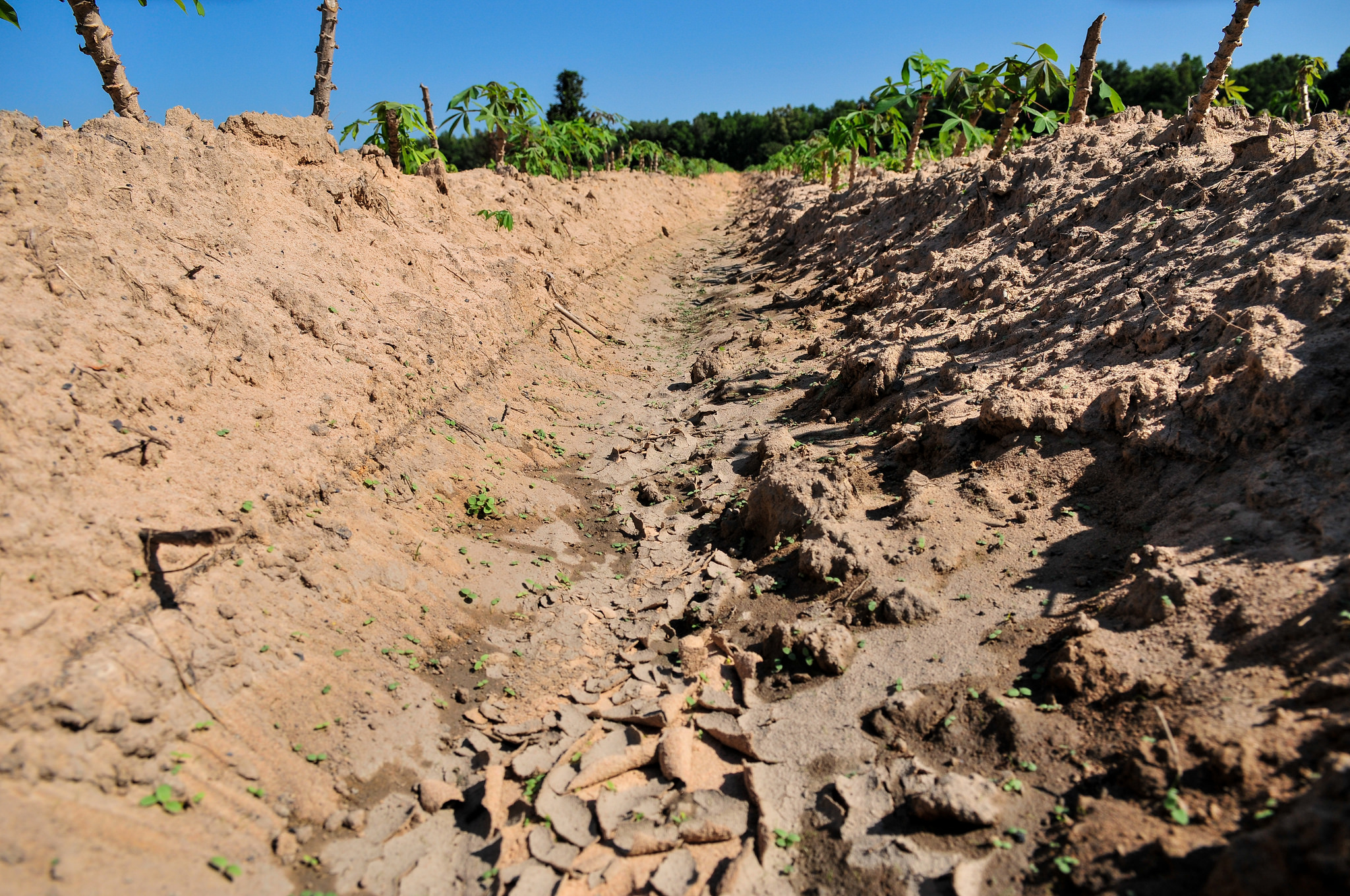
ចំការដំណាំដំឡូងមីនៅខេត្តសៀមរាប, ប្រទេសកម្ពុជា. រូបថត ដោយ CIAT, ថតនៅថ្ងៃទី ០៩ ធ្នូ ២០១៤។ ក្រោមអាជ្ញាបណ្ណ CC BY-NC-SA 2.0
គ្រោះរាំងស្ងួតដែលកម្ពុជាធ្លាប់ជួបប្រទះកន្លងមក គឺជាគ្រោះនៃកង្វះទឹកដែលជាទូទៅបណ្តាលមកពី៖
- រដូវវស្សាមានភាពយឺតយ៉ាវ (ជាធម្មតាចាប់ផ្តើមពីខែឧសភា ឬមិថុនា ដល់ខែតុលា ហើយនាំមកនូវទឹកភ្លៀងប្រមាណ ៨០ភាគរយនៃបរិមាណទឹកភ្លៀងសរុបប្រចាំឆ្នាំ)
- រដូវវស្សាមានរយៈពេលខ្លី ឬមានភាពមិនប្រក្រតី
- ភ្លៀងធ្លាក់តិចជាងកម្រឹតមធ្យម
- កូនរដូវប្រាំងមានរយៈពេល ៣ សប្តាហ៍ ឬច្រើនជាងនេះក្នុងអំឡុងនៃរដូវវស្សា។ កូនរដូវប្រាំងជាទូទៅកើតឡើងនៅក្នុងខែសីហា។
គ្រោះរាំងស្ងួត ផ្តល់ផលប៉ះពាល់ទាំងផ្នែកសង្គម សេដ្ឋកិច្ច និងបរិស្ថាន ដល់ប្រជាជនកម្ពុជា ដោយសារប្រជាជនភាគច្រើនរស់នៅតាមទីជនបទ និងពឹងផ្អែកយ៉ាងខ្លាំងលើរបរកសិកម្ម។ សុវត្ថិភាពទឹក ត្រូវបានផ្សារភ្ជាប់យ៉ាងខ្លាំងជាមួយសុវត្ថិភាពស្បៀងអាហារ។ ភាពងាយរងគ្រោះនៃសហគមជាច្រើននៅទីជនបទ ជាមួយនឹងភាពធន់កម្រិតទាប និងធនធាននៅមានកម្រិតផងនោះ វាសរបញ្ជាក់ថា គ្រោះរាំងស្ងួតអាចត្រូវការការចំណាយច្រើន។
គ្រោះរាំងស្ងួតធ្ងន់ធ្ងរបានប៉ះទង្គិចដល់ប្រទេសកម្ពុជាអស់រយៈពេលជាច្រើនឆ្នាំ។ គ្រោះរាំងស្ងួត ជាញឹកញាប់ប្រែប្រួលពីខេត្តមួយទៅខេត្តមួយ ជាមួយគ្នានេះដែរ ខេត្តដែលរងការប៉ះពាល់ខ្លាំងជាងគេមាន ខេត្តកំពង់ស្ពឺ តាកែវ និងបាត់ដំបង។ នៅកម្រិតថ្នាក់ជាតិ ក្នុងសតវត្សនេះមានគ្រោះរាំងស្ងួតបានកើតឡើងច្រើនដូចជានៅក្នុងឆ្នាំ ២០០២, ២០០៣, ២០០៤ (មានរយៈពេលយូរ និងប៉ះពាល់ខ្លាំងរហូតដល់ឆ្នាំ ២០០៦) និងឆ្នាំ ២០១៦។
យ៉ាងណាមិញ គ្រោះរាំងស្ងួតក្នុងឆ្នាំ ២០១៦ គឺជាគ្រោះរាំងស្ងួតដែលធ្ងន់ធ្ងរបំផុតក្នុងរយៈពេលប៉ុន្មានទស្សវត្សនេះ។ គ្រោះរាំងស្ងួតនេះកាន់តែអាក្រក់ដោយសារវត្តមាននៃបាតុភូតអាកាសធាតុ El Niño ចាប់តាំងពីឆ្នាំ ២០១៥ ដែលបណ្តាលឱ្យមានភ្លៀងធ្លាក់ទាបជាងកម្រិតមធ្យម។
អង្គការសហប្រជាជាតិបាននិយាយថា ទន្លេមេគង្គបានស្រកដល់កម្រិតទាបបំផុត តាំងពីកំណត់ត្រាទិន្នន័យចាប់ផ្តើមបានប្រហែលជិត ១០០ឆ្នាំមុន។1 ក្នុងខែមីនា ឆ្នាំ២០១៦ កម្រិតទឹកទន្លេបានធ្លាក់ចុះ ៣០ ទៅ ៥០ ភាគរយ ធៀបទៅនឹងកម្រិតមធ្យមនៅពេលដូចគ្នានៃឆ្នាំកន្លងទៅ។2
គិតត្រឹមខែឧសភា ឆ្នាំ២០១៦ គណៈកម្មាធិការជាតិគ្រប់គ្រងគ្រោះមហន្តរាយ បាននិយាយថា ប្រជាជន ២.៥ លាននាក់នៅក្នុងប្រទេសកម្ពុជាត្រូវបានរងការប៉ះពាល់ផ្ទាល់ពីគ្រោះរាំងស្ងួត។3 លោក កែវ វី អ្នកនាំពាក្យនៃគណៈកម្មាធិការជាតិគ្រប់គ្រងគ្រោះមហន្តរាយ បានរាយការណ៍ថា “គ្រោះរាំងស្ងួតកាលពីពេលកន្លងទៅបានប៉ះពាល់ត្រឹមតែផ្នែកមួយចំនួននៃប្រទេសប៉ុណ្ណោះ ប៉ុន្តែគ្រោះរាំងស្ងួតពេលបច្ចុប្បន្ននេះគឺកំពុងប៉ះពាល់នៅទូទាំងប្រទេស។”4 នៅក្នុងអត្ថបទសង្ខេបមួយរបស់ ACAPS ចេញថ្ងៃទី ០៣ ខែឧសភា ឆ្នាំ២០១៦ បានពណ៌នាថា គ្រោះរាំងស្ងួតនេះ អាក្រក់ដូចគ្រោះរាំងស្ងួតអំឡុងពេល ៥០ឆ្នាំមុន។5
គ្រោះរាំងស្ងួតនៅកម្ពុជា
គ្រោះរាំងស្ងួតនៅកម្ពុជា គឺជាគ្រោះមហន្តរាយដែលបណ្តាលឱ្យមានការខូចខាត និងការបាត់បង់ ទ្រព្យសម្បត្តិទីពីរបន្ទាប់ពីគ្រោះទឹកជំនន់។ គ្រោះរាំងស្ងួតត្រូវបានគេប៉ាន់ប្រមាណថា បានចូលរួមចំណែកទទួលខុសត្រូវ ២០ភាគរយនៃការបាត់បង់ផលស្រូវ ចាប់ពីឆ្នាំ ១៩៩៧ ដល់ឆ្នាំ ២០១០។6
អាកាសធាតុរាំងខុសធម្មតានៅក្នុងឆ្នាំ ២០០២ បានប៉ះពាល់ដល់ខេត្តចំនួន ១០ និងប្រជាជនចំនួន ២,០៤៧,៣៤០ នាក់។ តម្លៃនៃការខូចខាតនេះត្រូវបានប៉ាន់ប្រមាណថា ច្រើនជាង ២១.៥០ លានដុល្លារអាមេរិក។7
គ្រោះរាំងស្ងួតធ្ងន់ធ្ងរដែលកើតឡើងក្នុងអំឡុងពេលនៃរដូវកាលដាំដុះដំណាំស្រូវអាចធ្វើឱ្យសក្តានុពលនៃការប្រមូលផលត្រូវបានធ្លាក់ចុះជាង ៨០ភាគរយ។8
ការឆ្លើយតបថ្នាក់ជាតិទៅនឹងគ្រោះរាំងស្ងួត
គណៈកម្មាធិការជាតិគ្រប់គ្រងគ្រោះមហន្តរាយ គឺជាភ្នាក់ងាររដ្ឋាភិបាលទទួលខុសត្រូវសម្រាប់ការគ្រប់គ្រងគ្រោះមហន្តរាយធម្មជាតិនានា ហើយក្រសួងបរិស្ថាន ទទួលខុសត្រូវលើបញ្ហាការប្រែប្រួលអាកាសធាតុ។ ក្រសួងកសិកម្ម រុក្ខាប្រមាញ់ និងនេសាទ និងក្រសួងធនធានទឹក និងឧតុនិយម មានតួនាទីដោះស្រាយបញ្ហានានាដែលប៉ះពាល់ដល់វិស័យកសិកម្ម និងធនធានទឹក។
កិច្ចផ្តួចផ្តើមសម្រាប់ដោះស្រាយបញ្ហាគ្រោះរាំងស្ងួតរួមមាន៖
- ក្របខណ្ឌ Hyogo សម្រាប់សកម្មភាព ២០០៥-២០១៥9
កម្ពុជាជាហត្ថលេខីមួយនៅក្នុងក្របខណ្ឌអន្តរជាតិនេះ សម្រាប់ចែករំលែកចំណេះដឹងស្តីពីគ្រោះថ្នាក់ធម្មជាតិ និងគ្រោះមហន្តរាយនានា និងការអនុវត្តវិធានការកាត់បន្ថយហានិភ័យគ្រោះមហន្តរាយ។ សកម្មភាពជាអាទិភាពទាំងប្រាំនៃក្របខណ្ឌនេះ មានដូចជា៖- ធានាថា ការកាត់បន្ថយហានិភ័យនៃគ្រោះមហន្តរាយ គឺជាអាទិភាពថ្នាក់ជាតិ និងថ្នាក់ក្រោមជាតិ ជាមួយនឹងមូលដ្ឋានស្ថាប័នរឹងមាំសម្រាប់ការអនុវត្ត
- កំណត់អត្តសញ្ញាណ ពិនិត្យនិងតាមដានហានិភ័យគ្រោះមហន្តរាយ និងបង្កើនប្រសិទ្ធិភាពប្រព័ន្ធដាស់តឿនជាមុន
- ប្រើប្រាស់ចំណេះដឹង ការច្នៃប្រឌិត និងការអប់រំ ដើម្បីកសាងវប្បធម៌នៃការរក្សាសុវត្ថិភាព និងភាពធន់នៅគ្រប់កម្រិត
- កាត់បន្ថយកត្តាហានិភ័យគោលដៅនានា
- បង្កើនការត្រៀមខ្លួនជាមុនសម្រាប់គ្រោះមហន្តរាយ ដើម្បីឱ្យមានការឆ្លើយតបប្រកបដោយប្រសិទ្ធិភាពនៅគ្រប់កម្រិត
- ផែនការសកម្មភាពយុទ្ធសាស្ត្រថ្នាក់ជាតិស្តីពីការកាត់បន្ថយហានិភ័យនៃគ្រោះមហន្តរាយ ២០០៨-២០១៣ ដើម្បីអនុវត្តន៍ក្របខណ្ឌសកម្មភាព Hyogo។
- កម្មវិធីបន្ស៊ាំខ្លួនទៅនឹងការប្រែប្រួលអាកាសធាតុថ្នាក់ជាតិ ត្រូវបានអនុម័តដោយគណៈរដ្ឋមន្ត្រីនៅក្នុងឆ្នាំ ២០០៦។ កម្មវិធីនេះ ផ្តល់ក្របខណ្ឌមួយដើម្បីដឹកនាំការសម្របសម្រួល និងការអនុវត្តនៃកិច្ចផ្តួចផ្តើមការបន្ស៊ាំនេះ ដែលធ្វើការសហការជាមួយកម្មវិធីនានាដែលពាក់ព័ន្ធនឹងបរិស្ថាន និងការអភិវឌ្ឍ។ ក្រសួងកសិកម្ម រុក្ខាប្រមាញ់ និងនេសាទ និងក្រសួងធនធានទឹក និងឧតុនិយម ជាក្រសួងមានតួនាទីលើការអនុវត្តនេះ។
- យុទ្ធសាស្ត្រសម្រាប់កសិកម្ម និងទឹក ២០១០-២០១៣ ដែលបានបង្កើតឡើងរួមគ្នាដោយក្រសួងធនធានទឹក និងក្រសួងកសិកម្ម ផ្តល់ក្របខណ្ឌយុទ្ធសាស្ត្រទោលមួយដែលណែនាំដល់ដំណើរការគោលនយោបាយ និងការធ្វើផែនការនៅក្នុងក្រសួងទាំងពីរ។
- ផែនការយុទ្ធសាស្ត្រស្តីពីការគ្រប់គ្រងការប្រែប្រួលអាកាសធាតុសម្រាប់ធនធានទឹក និងឧតុនិយម ២០១៣-២០១៧ ត្រូវបានបង្កើតឡើងដោយក្រសួងធនធានទឹក និងឧតុនិយម ដែលជួយដល់ការបន្ស៊ាំខ្លួន និងកាត់បន្ថយផលប៉ះពាល់នានានៃការប្រែប្រួលអាកាសធាតុ។
នៅកម្ពុជា បញ្ហាគួរឱ្យព្រួយបារម្ភធំជាងគេបំផុតដែលបណ្តាលមកពីផលប៉ះពាល់នៃការប្រែប្រួលអាកាសធាតុនោះគឺ គ្រោះទឹកជំនន់ និងគ្រោះរាំងស្ងួត។10 ម៉ូដែលនានានៃការប្រែប្រួលអាកាសធាតុដែលបានអនុវត្តន៍នៅកម្ពុជាបានបង្ហាញថា រដូវវស្សាកាន់តែជន់ខ្លាំង ហើយរដូវប្រាំងកាន់តែហួតហែង។11
ជាមួយគ្នានឹងកម្មវិធីគ្រប់គ្រងការប្រែប្រួលអាកាសធាតុរបស់រដ្ឋាភិបាល ក្នុងនោះដែរមានគម្រោងចំនួន ៩ ដែលមានគោលដៅកាត់បន្ថយគ្រោះរាំងស្ងួត និង ៥ គម្រោងទៀតដើម្បីកាត់បន្ថយផលប៉ះពាល់នៃគ្រោះទឹកជំនន់។ គម្រោងនៃគ្រោះរាំងស្ងួតទាំងអស់ ត្រូវបានផ្តោតទៅលើប្រព័ន្ធស្រោចស្រព ដូចជាការស្ថាបនាអាងស្តុកទឹកជាដើម។12
កម្ពុជា មិនទាន់មានការណែនាំប្រព័ន្ធព្រមានទុកមុនថ្នាក់ជាតិសម្រាប់គ្រោះរាំងស្ងួតនោះទេ បើទោះបីជាអ្នកសង្កេតការណ៍នានាបាននិយាយថា ប្រព័ន្ធទាំងនោះ ត្រូវបានទាមទារឱ្យមានជាបន្ទាន់ក៏ដោយ។13
ការរីងហួតនៃអណ្តូងទឹកនៅក្នុងឆ្នាំ ២០១៦
នៅក្នុងឆ្នាំ ២០១៦ អណ្តូងជាច្រើនកំពុងត្រូវបានជីកកាន់តែជ្រៅជាងមុនដើម្បីទទួលបានទឹក។ ក្រសួងធនធានទឹក និងឧតុនិយម បានរាយការណ៍កាលពីខែឧសភា ឆ្នាំ ២០១៦ថា អណ្តូងជាច្រើនដែលមានជម្រៅ ៣០ ទៅ ៤០ ម៉ែត្រនៅជុំវិញប្រទេសត្រូវបានចាប់ផ្តើមរីង ហើយអណ្តូងជម្រៅ ៦០ម៉ែត្រមួយចំនួនក៏កំពុងជួបប្រទះបញ្ហាដូចគ្នាដែរ។14
អាជ្ញាធរតាមខេត្តមួយចំនួនកំពុងស្នើរសុំជីកអណ្តូងជម្រៅ ១០០ ម៉ែត្របន្ថែម។ នេះគឺជាការចំនាយដ៏ច្រើន ខណៈដែលការចំនាយសម្រាប់ជីកអណ្តូងជម្រៅ ៣០ ម៉ែត្រអាចនឹងមានតម្លៃ ៥០០ដុល្លារ ហើយសម្រាប់អណ្តូងជម្រៅ ១០០ ម៉ែត្រវិញអាចនឹងមានតម្លៃ ៧,០០០ ដុល្លារ។15
កង្វះទឹក គឺមិនមែនជាបញ្ហាដោយសារខ្វះខាតទឹកភ្លៀងតែមួយមុខនោះទេ ប៉ុន្តែអាចបណ្តាលមកពីការប្រើប្រាស់ទឹកក្រោមដីដ៏ច្រើនផងដែរ។ ការសិក្សាមួយនៃសាកលវិទ្យាល័យ Stanford ដែលបានចេញផ្សាយកាលពីខែកុម្ភៈ ២០១៦ បានរកឃើញថា ការប្រើប្រាស់ទឹកក្រោមដី គឺកំពុងតែកើនឡើង ១០ភាគរយជារៀងរាល់ឆ្នាំ។16 ការសិក្សាបានរកឃើញថា ការដាំដុះដែលអាស្រ័យទឹកក្រោមដីអាចធ្វើឱ្យកម្រិតទឹកក្រោមដីធ្លាក់នៅក្រោមកម្រិតមួយដែលអនុញ្ញាតឱ្យម៉ាស៊ីនបូមទឹកធម្មតាអាចប្រតិបត្តិការបានក្នុងរយៈពេល ១៥ឆ្នាំ។
គ្រោះរាំងស្ងួត និងតម្រូវការសម្រាប់ការស្រោចស្រព
វាមានសំពាធច្រើនគួរសមក្នុងការបង្កើនការដាំដុះដំណាំស្រូវនៅកម្ពុជាដើម្បីកាត់បន្ថយភាពក្រីក្រ និងដើម្បីជម្រុញសេដ្ឋកិច្ច និងកំណើននៃការនាំចេញនៃប្រទេសនេះ។ យ៉ាងណាមិញ ប្រហែល ៩៦ភាគរយនៃដីដែលបានដាំដុះដំណាំស្រូវនៅក្នុងរដូវវស្សាត្រូវបានទុកទំនេរនៅក្នុងរដូវប្រាំង17 ដោយភាគច្រើនបណ្តាលមកពីការស្រោចស្រពមានកម្រិត និងភាពរាំងស្ងួតនៅរដូវប្រាំង។18
ការស្រោចស្រព ជាញឹកញាប់ត្រូវបានលើកជម្រុញដើម្បីបង្កើនទិន្នផលដំណាំស្រូវ ប៉ុន្តែដើម្បីស្រោចស្រពលើផ្ទៃដីដ៏ធំ បរិមាណទឹកដែលត្រូវការ គឺច្រើនសន្ធឹកសន្ធាប់។ ការស្រោចស្រពដីនៅក្នុងតំបន់អាងទន្លេមេគង្គនៅកម្ពុជា ត្រូវបានគេប៉ាន់ប្រមាណថា អាចនឹងត្រូវការទឹកស្មើរនឹង ៣១ភាគរយនៃទឹកដែលហូរនៅក្នុងទន្លេមេគង្គនារដូវប្រាំង។
ពេលអនាគត
ការស្រាវជ្រាវកំពុងចង្អុលបង្ហាញផ្លូវដើម្បីគ្រប់គ្រងហានិភ័យមួយចំនួនជុំវិញបញ្ហាគ្រោះរាំងស្ងួត។ ដោយអាស្រ័យលើកាលៈទេសៈ ដំណោះស្រាយអាចរាប់បញ្ជូលការជ្រើសរើសប្រភេទស្រូវ ការដាំដុះនៅពេលវេលាខុសៗគ្នា ឬជម្រៅនៃការដាំស្រូវ។ រួមមានដំណោះស្រាយតាមមូលដ្ឋាន៖ ជាឧទាហរណ៍ មានការសិក្សាមួយបានធ្វើតេសពីសក្តានុពលនៃការស្តាឡើងវិញនៃអាងស្តុកទឹកចាស់មួយ ហើយបានរកឃើញថាសន្ទស្សន៍អត្ថប្រយោជន៍ និងចំនាយស្មើរនឹង ២.៨ មានន័យថា អត្ថប្រយោជន៍មានតម្លៃសាកសមនឹងការចំនាយ។19 ការបណ្តុះបណ្តាល និងអប់រំកសិករ គឺជាផ្នែកមួយសំខាន់នៃរាល់ដំណើរការនេះ។
ធ្វើបច្ចុប្បន្នភាពនៅថ្ងៃទី ០៤ កក្កដា ២០១៦
ឯកសារយោង
- 1. របាយការណ៍រួមវៀតណាមស្តីពីគ្រោះរាំងស្ងួត និងការជ្រៀតចូលនៃទឹកប្រៃ ចន្លោះខែតុលា ២០១៥ ដល់ថ្ងៃទី១០ មីនា ២០១៦, ក្រុមគ្រប់គ្រងហានិភ័យនៃគ្រោះមហន្តរាយនៃអង្គការសហប្រជាជាតិ (UNDRMT)។ http://reliefweb.int/report/viet-nam/vietnam-consolidated-report-drought-and-saltwater-intrusion-reporting-period-oct
- 2. ដូចឯកសារយោងខាងដើម។
- 3. Igor Kossov, ឧសភា ២០១៦, “ការជិកអណ្តូងកាន់តែជ្រៅចំនាយកាន់តែច្រើន”, កាសែតភ្នំពេញប៉ុស្តិ៍, ថ្ងៃទី ១១ ឧសភា ២០១៦។ http://www.phnompenhpost.com/national/digging-deeper-wells-costs-more
- 4. Lauren Crothers ២០១៦ “សត្វជាច្រើនស្លាប់ខណៈដែលកម្ពុជាវាយប្រហារដោយគ្រោះរាំងស្ងួតដ៏អាក្រក់អស់រយៈពេលប៉ុន្មានទសវត្ស”, ០៥ ឧសភា ២០១៦។ https://www.theguardian.com/global-development/2016/may/05/animals-die-cambodia-worst-drought-decades
- 5. អត្ថបទសង្ខេបរបស់ ACAPS, ថ្ងៃទី៣ ឧសភា ២០១៦, គ្រោះរាំងស្ងួតនៅកម្ពុជា។ ចូលមើលថ្ងៃទី ១២ ឧសភា ២០១៦។ http://reliefweb.int/sites/reliefweb.int/files/resources/start_acaps_cambodia_drought.pdf
- 6. Nyda Chhinh, ២០១៥, គ្រោះរាំងស្ងួត, ភាពងាយរងគ្រោះ និងគោលនយោបាយបន្ស៊ាំខ្លួននៅកម្ពុជា, ចូលអាននៅថ្ងៃទី ១២ ឧសភា ២០១៦។ https://www.humanitarianresponse.info/sites/www.humanitarianresponse.info/files/documents/files/drought_drought_vulnerability_and_adaptation_policy_in_cambodia_with_reference_to_the_farming_sector_nyda_thesis_0.pdf
- 7. Chan Phaloeum, Khen Bopreang និង Cheth Kimngoy, “លក្ខខណ្ឌនានានៃគ្រោះធម្មជាតិ និងយុទ្ធសាស្ត្រគ្រប់គ្រងនៅកម្ពុជា”, ចូលមើលថ្ងៃទី ១៣ ឧសភា ២០១៦។ http://www.ais.unwater.org/ais/pluginfile.php/597/mod_page/content/79/Cambodia_2.pdf
- 8. Nyda Chhinh, ២០១៥, គ្រោះរាំងស្ងួត, ភាពងាយរងគ្រោះ និងគោលនយោបាយបន្ស៊ាំខ្លួននៅកម្ពុជា, ចូលអាននៅថ្ងៃទី ១២ ឧសភា ២០១៦។ https://www.humanitarianresponse.info/sites/www.humanitarianresponse.info/files/documents/files/drought_drought_vulnerability_and_adaptation_policy_in_cambodia_with_reference_to_the_farming_sector_nyda_thesis_0.pdf
- 9. ការិយាល័យសម្រាប់កាត់បន្ថយហានិភ័យនៃគ្រោះមហន្តរាយនៃអង្គការសហប្រជាជាតិ (UNISDR), ចូលអានថ្ងៃទី ១៣ ឧសភា ២០១៦។ https://www.unisdr.org/we/coordinate/hfa
- 10. Nyda Chhinh, ២០១៥, គ្រោះរាំងស្ងួត, ភាពងាយរងគ្រោះ និងគោលនយោបាយបន្ស៊ាំខ្លួននៅកម្ពុជា, ចូលអាននៅថ្ងៃទី ១២ ឧសភា ២០១៦។ https://www.humanitarianresponse.info/sites/www.humanitarianresponse.info/files/documents/files/drought_drought_vulnerability_and_adaptation_policy_in_cambodia_with_reference_to_the_farming_sector_nyda_thesis_0.pdf
- 11. Nyda Chhinh, ២០១៥, គ្រោះរាំងស្ងួត, ភាពងាយរងគ្រោះ និងគោលនយោបាយបន្ស៊ាំខ្លួននៅកម្ពុជា, ចូលអាននៅថ្ងៃទី ១២ ឧសភា ២០១៦។ https://www.humanitarianresponse.info/sites/www.humanitarianresponse.info/files/documents/files/drought_drought_vulnerability_and_adaptation_policy_in_cambodia_with_reference_to_the_farming_sector_nyda_thesis_0.pdf
- 12. Nyda Chhinh, ២០១៥, គ្រោះរាំងស្ងួត, ភាពងាយរងគ្រោះ និងគោលនយោបាយបន្ស៊ាំខ្លួននៅកម្ពុជា, ចូលអាននៅថ្ងៃទី ១២ ឧសភា ២០១៦។ https://www.humanitarianresponse.info/sites/www.humanitarianresponse.info/files/documents/files/drought_drought_vulnerability_and_adaptation_policy_in_cambodia_with_reference_to_the_farming_sector_nyda_thesis_0.pdf
- 13. Nyda Chhinh, ២០១៥, គ្រោះរាំងស្ងួត, ភាពងាយរងគ្រោះ និងគោលនយោបាយបន្ស៊ាំខ្លួននៅកម្ពុជា, ចូលអាននៅថ្ងៃទី ១២ ឧសភា ២០១៦។ https://www.humanitarianresponse.info/sites/www.humanitarianresponse.info/files/documents/files/drought_drought_vulnerability_and_adaptation_policy_in_cambodia_with_reference_to_the_farming_sector_nyda_thesis_0.pdf
- 14. Igor Kossov, ឧសភា ២០១៦, “ការជិកអណ្តូងកាន់តែជ្រៅចំនាយកាន់តែច្រើន”, កាសែតភ្នំពេញប៉ុស្តិ៍, ថ្ងៃទី ១១ ឧសភា ២០១៦។ http://www.phnompenhpost.com/national/digging-deeper-wells-costs-more
- 15. ដូចឯកសារយោងខាងដើម។
- 16. Laura E Erban and Steven M Gorelick, “ការឈានជិតដល់ឱនភាពនៃការស្រោចស្រពនៅកម្ពុជា៖ ផលប៉ះពាល់រួមបញ្ជូលគ្នាទៅលើទឹកក្រោមដី និងលំហូរទន្លេមេគង្គ”, ព្រឹត្តបត្រសិក្សាស្រាវជ្រាវជលសាស្ត្រ, ខែមេសា ២០១៦។
- 17. ដូចឯកសារយោងខាងដើម។
- 18. ដូចឯកសារយោងខាងដើម។
- 19. Nyda Chhinh, ២០១៥, គ្រោះរាំងស្ងួត, ភាពងាយរងគ្រោះ និងគោលនយោបាយបន្ស៊ាំខ្លួននៅកម្ពុជា, ចូលអាននៅថ្ងៃទី ១២ ឧសភា ២០១៦។ https://www.humanitarianresponse.info/sites/www.humanitarianresponse.info/files/documents/files/drought_drought_vulnerability_and_adaptation_policy_in_cambodia_with_reference_to_the_farming_sector_nyda_thesis_0.pdf

